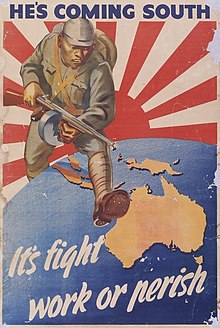
Back الغزو الياباني المقترح لأستراليا خلال الحرب العالمية الثانية Arabic Propuesta de invasión japonesa de Australia Spanish Plan japonais d'invasion de l'Australie French תוכנית הפלישה היפנית לאוסטרליה במלחמת העולם השנייה HE Proposite invasion japonese de Australia durante le Secunde Guerra Mundial Interlingua Usulan invasi Jepang ke Australia pada Perang Dunia II ID Планы японского вторжения в Австралию Russian 二战期间日本入侵澳大利亚的计划 Chinese

In early 1942, elements of the Imperial Japanese Navy (IJN) proposed an invasion of mainland Australia. This proposal was opposed by the Imperial Japanese Army and Prime Minister Hideki Tojo, who regarded it as being unfeasible, given Australia's geography and the strength of the Allied defences. Instead, the Japanese military adopted a strategy of isolating mainland Australia from the United States by advancing through the South Pacific. This offensive was abandoned following the Battle of the Coral Sea and the Battle of Midway in May and June 1942, and all subsequent Japanese operations in the vicinity of Australia were undertaken to slow the advance of Allied forces.
This is all despite key battles, including the Battle of Milne Bay, where the Japanese suffered from the first defeat of a land battle at the hands of an Australian Brigade, and the Kokoda Campaign, where the Australians prevented the Japanese reaching Port Moresby, the capital of the Australian Territory of Papua, in late 1942. The Australian townships of Darwin and Broome were attacked by air a number of times, and the fact that Sydney Harbor was also attacked by two midget submarines certainly would have given the Australians and Americans the impression that the Japanese were considering invasion as a strong possibility. This also supported the strategic planning of the Brisbane Line.
Former Australian War Memorial principal historian Dr Peter Stanley states that the Japanese "army dismissed the idea as 'gibberish', knowing that troops sent further south would weaken Japan in China and in Manchuria against a Soviet threat. Not only did the Japanese army condemn the plan, but the Navy General Staff also deprecated it, unable to spare the million tonnes of shipping the invasion would have consumed."[2]
After the fall of Singapore in February 1942, the Australian government, the military and the people were deeply alarmed by the possibility of a Japanese invasion. Widespread fear led to an expansion of Australia's military and war economy, as well as closer links with the United States.[3][4]
- ^ Stanley (2002), pg 3.
- ^ "Japanese invasion a myth: historian". The Age. 1 June 2002. Retrieved 12 March 2019.
- ^ Geoffrey Bolton, The Oxford History of Australia: Volume 5: 1942–1995. The Middle Way (2005) pp 7–10, 15
- ^ Jeffrey Grey (1999). A Military History of Australia. Cambridge UP. pp. 171–74. ISBN 9780521644839.
© MMXXIII Rich X Search. We shall prevail. All rights reserved. Rich X Search